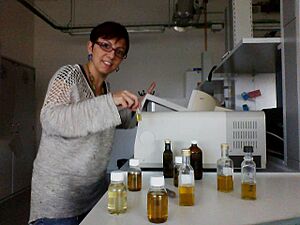Olive oil regulation and adulteration facts for kids
Have you ever wondered if the olive oil you use is real? Olive oil rules and fakes are big topics that many groups around the world study. These groups include governments, non-profit organizations, and scientists. They work to make sure olive oil is real and safe.
Contents
What is Olive Oil Regulation?
The International Olive Council (IOC) is a group of countries that work together. It is based in Madrid, Spain. This group helps promote olive oil globally. They keep track of how much olive oil is made. They also set rules for its quality and check if it is real. More than 98% of the world's olives grow in countries that are part of the IOC.
The United States is not a member of the IOC. So, the US Department of Agriculture does not officially use the IOC's rules. However, in 2011, the U.S. made its own new rules for olive oil. These rules help make sure that olive oil sold in the U.S. meets common quality standards.
The IOC has a lot of power over how olive oil is made and sold. They have clear terms for olive oil. But sometimes, these terms can be confusing on labels. Olive oil is sorted by how it's made, its chemical makeup, and its taste.
All olive oil starts by turning olives into a paste. This paste is then gently mixed. This helps tiny oil drops come together. The oil is taken out using either pressure (an old way) or spinning machines called centrifuges (a modern way). After the oil is out, what's left is called pomace. It still has a little oil in it.
The European Union (EU) also has rules for special labels. These labels show where olive oils come from. They are called "protected designation of origin."
Why Labels Can Be Tricky
In the U.S., customs rules say that if a label shows a country that didn't make the oil, the real country of origin must also be shown. It needs to be on the same side of the label and in letters of similar size. This is to avoid confusing shoppers.
But many big U.S. brands still put "imported from Italy" in large letters on the front. Then, they list other countries on the back in tiny print. These oils are often a mix from several countries. It's hard to know how much of the oil is truly from Italy. This makes it tough for real Italian olive oil makers to compete. It also makes it hard for good, cheaper oils from other places to be sold in the U.S.
What Happens When Olive Oil is Faked?
Real Italian extra-virgin olive oil is very popular and costs a lot. Because of this, making fake olive oil has become a big problem in the European Union. Only a small amount (less than 10%) of all olive oil made is truly "extra-virgin." But it's thought that up to 50% of olive oil sold in stores is labeled "extra-virgin."
Some oils labeled "extra-virgin" are actually mixed with cheaper olive oils. Or they might be mixed with other vegetable oils. Sometimes, very low-quality oil called lampante (or "lamp oil") is used. This oil comes from spoiled olives and is not allowed to be sold as food. Some people even colored cheap soy and canola oil with green coloring. They then added flavor to make it seem like olive oil.
In the United States, the Food and Drug Administration (FDA) does not regularly test imported olive oil for fakes. Some products are also hard to test.
In 2007, an article in The New Yorker magazine said that big Italian companies often fake olive oil. It claimed that only about 40% of oil sold as "extra virgin" was actually real. Sometimes, colza oil (another name for rapeseed oil) with added color and flavor was sold as olive oil.
This big problem led the Italian government to make a new labeling law in 2007. It said that every bottle of Italian olive oil had to show where it was made. For mixed oils, it had to show exactly what oils were used. But in 2008, EU officials said this law should be optional, not required. Under EU rules, olive oil can be sold as Italian even if it has only a small amount of Italian oil.
Past Problems and Recalls
- In 1993, the FDA ordered a recall of Rubino U.S.A. Inc. olive oils. These oils were actually just canola oil.
- In 1997, the Canadian Food Inspection Agency started testing olive oils. In 1999, they found that 20% of oils claiming to be 100% olive oil were fake. In 2013, tests showed that one in four olive oils in Spain and almost one in three in Canada failed fraud tests.
- In March 2008, Italian police found a large plan to relabel oils from other Mediterranean countries as Italian. They arrested people and took over farms.
- In April 2008, another operation found people adding green coloring to sunflower and soybean oil. They sold it as extra virgin olive oil. About 25,000 liters of this fake oil were stopped from being sent abroad.
- In December 2008, police in La Rioja (Spain) warned about fake olive oil being sold.
- In 2010, researchers at the University of California at Davis tested olive oils. They bought 14 imported oils and 5 California oils. All were labeled "extra-virgin." They found that 69% of the imported oils and 10% of the California oils did not meet taste standards for extra-virgin olive oil.
In 2011, a prosecutor in Florence, Italy, charged managers from Carapelli and Pietro Coricelli. They were accused of using fake documents and food fraud. Later, in 2017, an Italian group found them guilty of unfair business practices. They were fined a lot of money. Also in 2017, tests showed that oils from brands like Bertolli and Carapelli, labeled "extra virgin," were actually only "virgin" quality.
Standards Australia has rules for testing olive oils. But the rules for labeling are not required. The Australian Olive Association wants supermarkets to follow these rules. After testing in 2012, all imported extra-virgin olive oils did not meet the standard for their certification.
Usually, fake olive oil is not dangerous. It just means you are buying a lower-quality product. But sometimes, it can be very serious. In 1981, many people in Spain got sick from rapeseed (canola) oil that was mixed with a harmful chemical. This oil was sold as olive oil.
How to Test for Purity
Finding fake olive oil is often hard. No single test can do it all. Scientists use many tests to check if olive oil is real. They look at things like its acidity, how much it has oxidized, and its chemical makeup. Special methods using machines like chromatography and spectroscopy are also used.
These test results are compared to the International Olive Council's rules. This helps find anything unusual. Each test gives important clues to figure out the oil's quality and if it's been faked. However, the IOC does not test for a process called "deodorization." This process removes taste, color, and nutrients from low-quality oil. Then, color and a little real extra-virgin oil are added back. This makes up most of the fake extra-virgin oils.
Quality Seals and Certifications
The North American Olive Oil Association has a Quality Seal Program. This program helps make sure olive oil is real. Members of this group agree to have their oils tested twice a year. These tests check for taste, smell, and chemical purity. The oils are bought from stores, so they are the same ones consumers buy. Brands pay a fee for this testing.
The California Olive Oil Council also tests olive oil. Producers send in samples of their oil to be checked for extra virgin quality. These tests mainly look at taste, but also some chemical aspects.
The Extra Virgin Alliance offers the EVA Mark. This mark shows quality and authenticity. Their standards include taste and chemical checks for olive oils, even up to their "Best Before Date."
Simple Home Tests (Not Always Reliable)
The Refrigerator Test
Many people believe that real olive oil will get thick or solid in the refrigerator. This is a common idea, but it's often wrong. Olive oil is mostly made of a fat called oleic acid. Pure oleic acid does get solid in the fridge. But olive oil is a mix of many different fats and other things. These other parts can change its freezing point. So, many olive oils will not get solid in the fridge. In fact, some cheaper oils might be more likely to solidify!
Scientists at the University of California, Davis tested this "fridge test." They put seven different oils in a refrigerator. After several days, some oils started to thicken, but none became completely solid. The oils that were 100% extra virgin or a mix with extra virgin oil did thicken a little after a week. But other oils stayed clear. The scientists concluded that the refrigerator test is not a good way to tell if olive oil is fake. However, if your olive oil stays completely clear after a week in the fridge, it might not be pure extra virgin.
The Ignition Test
Pure olive oil should burn in an oil lamp. But like the fridge test, the ignition test is not a sure way to tell if olive oil is real.
Images for kids




